Whether you’re heading to a warmer climate for winter, own a convertible or classic car, or just aren’t driving right now, storing your car properly can prevent an array of problems. The right storage may even help you avoid paying hundreds of dollars on car repairs. For example, a storage mistake could lead to:
- Blemishes or rust on your paint job
- Mechanical problems
- Rodents taking up residence in your tailpipe or under the hood
To prevent these problems, follow this step-by-step guide to storing your car correctly in winter or any season:
1. Make Sure Your Car Is Insured
It’s important to protect your car with standard car insurance or classic car insurance, even when it’s in storage. There are several reasons to avoid letting your policy lapse even when you’re not driving the car. First, a gap in coverage could cause your premium to increase once you’re ready to reinsure your car. Second, if something happens to your car while it’s in storage (e.g., a tree topples onto it), insurance can help cover the costs of repairs.
If you own the car outright, it’s a good idea to maintain your comprehensive coverage. As long as you don’t plan to drive your car, or allow others to drive it, you can drop your collision coverage. Note that if you have an auto loan, your lender might require you to carry both comprehensive and collision insurance at all times.
Depending on your insurer, you can update your address and make changes to your coverage online.
2. Decide Where to Store Your Car
If possible, store your car in a dry location with a concrete floor, such as your garage or an indoor storage unit. Many self-storage facilities offer indoor and/or outdoor vehicle storage options. You can safely store your car in the elements for several months if you cover it properly, says Lauren Fix, aka “The Car Coach,” a nationally recognized automotive expert. However, if you need to store your car for years, you should store it inside.
3. Swap Out Fluids
Leaving dirty, used oil in your car can cause engine damage. Therefore, if you plan to store your car for a month or more, have the oil changed. Refill your engine using oil that is specially formulated for storage. And if you haven’t changed your coolant for more than a year, drain and replace it with quality antifreeze.
4. Fill Up the Tank
Hit the gas station and fill ‘er up before storing your car. Topping off the tank keeps water out and seals lubricated. Add a fuel stabilizer designed for cars in storage to your gas tank, Fix advises. This will extend the life of your gasoline and help prevent the formation of deposits, known as “varnishing,” that can plug up your fuel injectors and cost $300 to $400 to fix, she says. Another option is to drain your gas tank, but that’s not necessary if you’re only storing your car for the season.
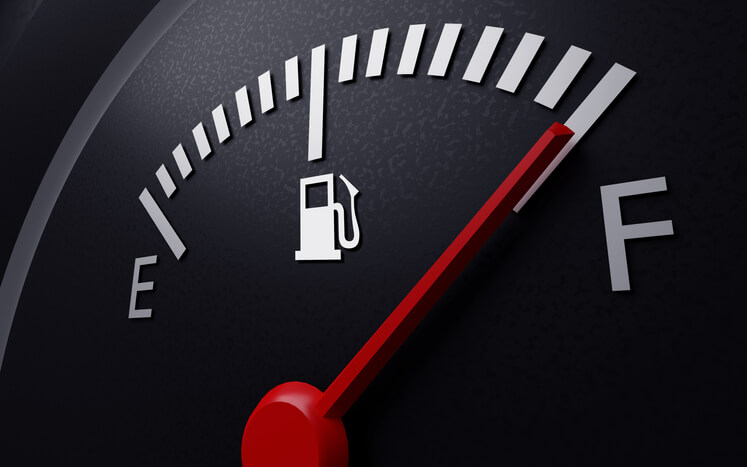
5. Safeguard Your Battery
If your car won’t be driven periodically (say, by a grandchild), buy a trickle charger (a.k.a. battery maintainer), Fix suggests. This inexpensive device helps your battery maintain power instead of gradually losing it over time. “If you let it sit more than six months, you’re more than likely going to have a dead battery,” she warns. Save yourself the hassle, and possibly the cost of towing, by shelling out $40 or so for this handy little device.
6. Take Care of Your Tires
Inflate your tires to the maximum recommended tire pressure, recommends Kevin Burke of SimpleTire.com, a website dedicated to finding tires for your car at competitive prices. “Tires can lose pressure over time when there are changes in temperature,” Burke explains. Loss of tire pressure can lead to “flat spots” on the bottom of the tires.
Sometimes, you can get rid of these spots by inflating your tires and driving your car, but that doesn’t always work. Flat spots can ruin your tires, requiring you to spend hundreds of dollars to replace them. To ensure your tires remain in good repair, you can remove them and use jack stands to hold your car off the ground.
7. Remove Wiper Blades
Take the wiper blades off your car to keep them from sticking to the windshield or becoming misshapen from staying in the same position for too long.
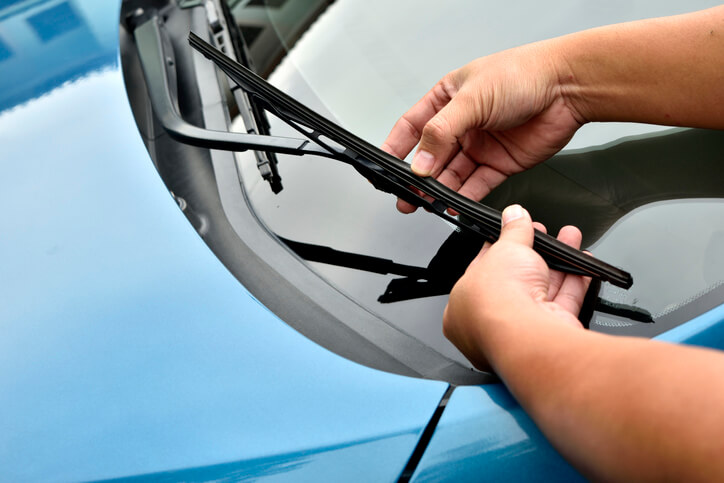
8. Release the Brake
To prevent the brake pads from sticking to the rotors, don’t engage the parking break when storing your car. Instead, if necessary, use a tire stopper to keep the car in place.
9. Keep Critters Away
Put a rubber ball or rag in the tailpipe to prevent mice or insects from setting up shop there. Also, cover heater vents or other openings that could provide access to cozy nesting spaces. As a third precaution, place mothballs around the edges of your vehicle to drive away critters.

10. Bring On the Suds
Wash your car to remove bird excrement, tree sap or other substances that could damage your car’s paint if left on it for several months. Make sure to also clean the fenders and the tires to get rid of dirt and grease. Apply a coat of wax to your car to protect its exterior while it’s stored, Fix recommends. “That way, in spring you’ll have a nice clean car, ready to go,” she says.
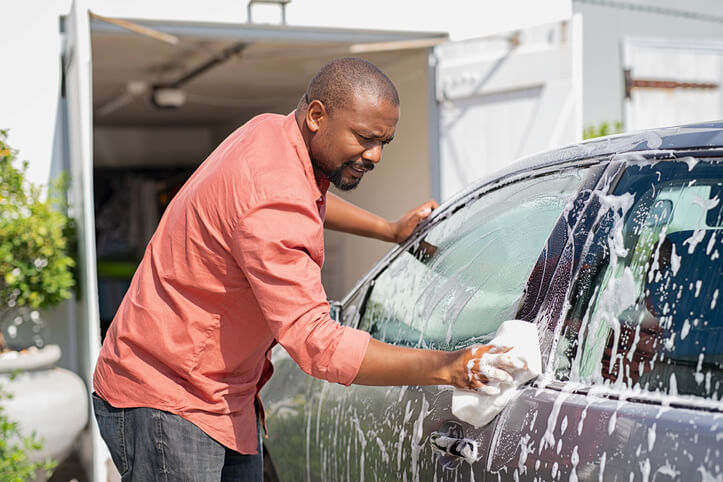
11. Get a Pad to Soak Up Leaks
Certain vehicles leak fluid while sitting, especially high performance cars or older cars, Fix says. Buy an absorbent mat designed to go underneath a car during storage to keep leaks from staining the driveway, garage or storage space floor.
12. Cover Your Car
Whether your car is sitting in your driveway, your garage or a special storage facility, you should keep it covered while you’re away. Use a good quality car cover, Fix warns. If you’re storing your car outside, you’ll need a weatherproof car cover to protect it from rain, sleet and snow. If you’re storing your ride inside, use a soft cotton cover, she advises.
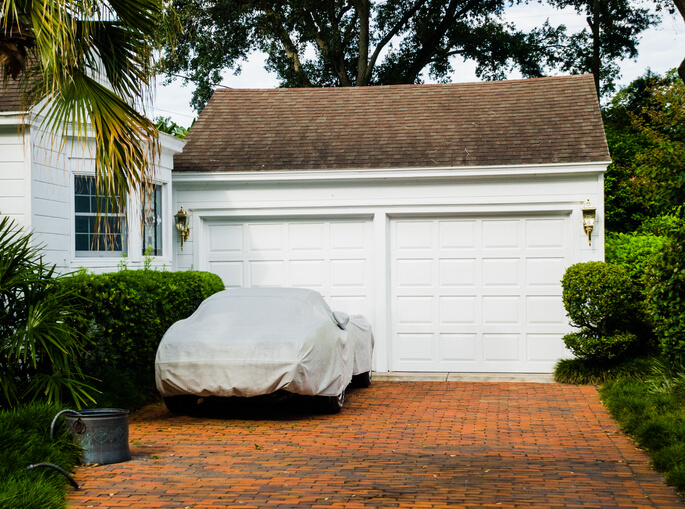
When It’s Time to Drive
When it’s time to drive your car again, first, remove the ball or rag from your tail pipe. Then, put the wiper blades back on. Drive your car around until the gas tank is almost empty to clean out the fuel stabilizer from the system, Fix says. Add a fuel injection system cleaner to the nearly empty gas tank before filling it up, she recommends.



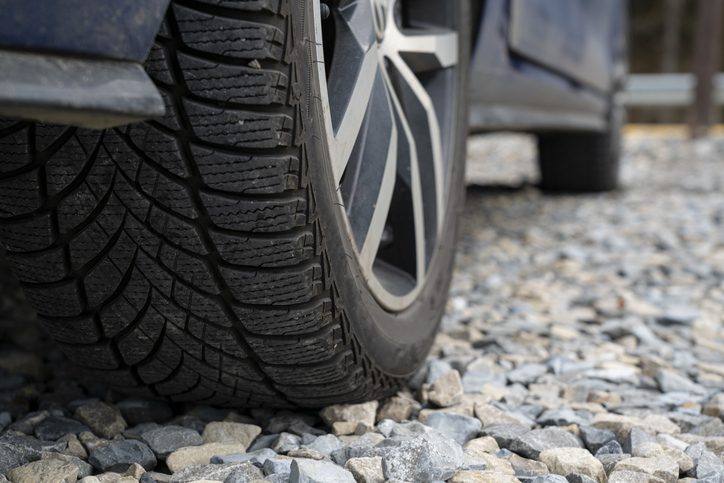



I store my car in FL in the summer when I go north and had major issue with square tire syndrome when returning two years ago. There are styro-foam pads you can purchase to place under the tires that helps reduce the issue. Place pads on garage floor or where ever you store the car and drive car onto the pads.
Lots of great info here, However one important fact has been left out. Only store your gas motors with non ethanol premium fuel! Sea foam is great, but I still had problems with ethanol fuel even with Sea Foam. I leave my tanks about half full and then add fresh non ethanol fuel and Sea Foam for fast smooth starts after 6 months of storage.
I have to leave one car in a garage for 3 o4 4 weeks or more at times. I bought a charger that has settings for 2amp charge, 10ampcharge, or START. I use trickle chargers since I heard they are not the best because continuous charge causes heating wear on the battery. So when I come back I usually put the charger on 2amp for a few hours to get it up to the point where the car can start on its own. Or if battery is too far down to start it, I use the START (like a jumpstart) to boost the battery to start–but I like to avoid that if I can
I was an ASE certified parts specialist working at a major auto parts sales chain for over 8 years. There is one thing I have found, and many of my customers relied upon, Seafoam. You can get it formulated for the fuel, or for the crankcase. It dissolves the varnish left by gasoline that has been sitting too long in an unused motor.
I have had to leave my lawnmower outside all winter one time and expected to take it to a repair shop. But first I tried adding about 1/4 can of SF. It did fire, but barely. After about five minutes it started running slightly more smoothly, and after 15 minutes of mowing, it picked up speed and started running normally.
Just a month ago I decided to fire up my 96 Ford Ranger, which had been sitting unused for about 9 months. It almost didn’t start, but finally reluctantly did. It would NOT idle. It had less than 1/4 tank of old gas. I dumped in an entire can of SF and a bottle of octane boost. It then would run well enough to get down to a gas station to add fresh gas, but still wouldn’t idle.
I have used it for several errands since, for things that won’t (or shouldn’t) fit inside my Kia Spectra (not a truck!) and now it is just fine, no repair shop needed.
SF is the only fuel additive I use, it cleans out the fuel system very nicely and saves a lot of trouble
I have a 66 convertible that I have stored every winter for over 20 years.
I take a cheap easy to use wax (turtle wax) and wax the whole car and the Crome and leave it on all winter. It not only protects the paint but it keeps the Crome from pitting. In the spring I give it go was and wax with a higher grade wax.
It still shines like new!
To Stephen Barnett —
Have you: 1) checked to make sure all the wires under the hood are tightly fitted in place, 2) that there are no animal chew marks on any of the wires, and 3) that there is no corrosion on the battery posts? If all that checks out okay and the motor is spinning over normally but isn’t catching (starting) then I would wager the problem is somewhere in the fuel line between the tank and the motor. I say this because if the truck ran perfectly fine when you drove it into storage six months ago it is extremely unlikely that an electrical component like a coil or starter relay suddenly died sitting unused. If the problem is in the fuel line then the likely culprits are a dead fuel pump, a clogged fuel filter, or a blockage in the fuel line or at the fuel injector(s). Your truck has a fuel filter and its located somewhere around the engine compartment or under the vehicle. I’m pretty certain your Ford has its fuel pump inside the fuel tank. To see what a fuel filter looks like for your truck, look up the part at Autozone or O’Reilly’s.
https://www.oreillyauto.com/shop/b/fuel—emissions-16775/carburetors—parts-16801/fuel-filter-water-separator-12305/6bf814fc80d2/2011/ford/ranger?q=fuel+filter
I have a 2011 Ford Ranger that won’t start after being stored in a garage for approximately 6 months. Battery is only one year old. It sounds like it is going to start but just can’t quite make it!
Any suggestions as to what might be the problem?
Charge the battery or get a jump start. If the truck starts, it had to be the battery. Six months is a long time, even the best of batteries can discharge enough to give you a problem.
Pull the battery and have it checked out for free at most any auto parts store.
This may seem like a no-brainer, but a DampRid bucket placed inside a car or 2-3 inside an RV will keep the moisture level down and condensation lower in humid climates. Irish Spring soap bar will also repel rodents….they hate it!
I have a rule that the garage is to Park the car. We are subject to hail damage in my State and someone could break in, so I always park the car inside the garage
Great advice especially during this CORVIP-19 – You can`t go anywhere
If your parking on concrete you should always cover floor with plastic sheet to block moisture saves exhaust system and rusted frames etc
Store my car for 5 months or so in an unheated garage in a very cold climate. Tricle chargers are potentially dangerous so I just disconnect the negative terminal of battery and put this terminal in plastic. My car has restarted each spring. Hope this works on my new Subaru.
2@
As a lubrication specialist, and car restorer/collector, I see many valid points, but there is no oil specially formulated for storage. Oil should be changed (with the correct API certified oil of the right viscosity) if you are leaving it more than 2 months unless it is fairly new, then maybe 3 or 4. And should always be changed at least once a year, so for many, this is the time of the year for that change. It is fine to run when you get back. And never start it during that time unless you are going to get it really up to temperature for 20 minutes or more.
Only the green coolant needs annual changes. OAT is generally a 10 year coolant, HOAT is generally a 6 year coolant. Just make sure you never mix types.
I don’t like to put extra air pressure in the tires, as it makes them more apt to dry from oxidation (dry-rot).
Due to Covid restrictions, I have 3 cars sitting since February 2020, and one sitting since July, but all with freshly changed oil, all waxed, and all under roof. One has a battery maintainer, the rest are disconnected.
I have stored my cars over the years because I work remote and even my last Car storage yard knows that It’s not good to store a car; and for that reason they quit doing it Chevrolet recommends to run a car once every two weeks, but you have to do what you gotta do.
It is a good idea to check all rubber products( Electrical wiring, and hoses, and belts ) on and in the car or motor home for cracks and being chewed by animals(rats, Mice, Squirrels etc) when you store the vehicle and when you take it out of storage. You do not want it to break down on your pleasure drive. Heat and Sun causes sidewall cracking( hazard for a blowout) as well as upholstery. Clean the car inside and out- plastic dashes put off a gas which leaves a film on your windows-Especially the windshield and back window. If you put your car on Jackstands there is no need to pull the wheels as long as they are high enough to freewheel. Let about 5 lbs of air out because they will expand with the heat and you do not have to worry about flat spots. Pressure wash underneath the car to get rid of the road salt because the animals like the salt and nibble away at it causing damage to your undercoating or rubber. One time a porcupine decided my Motor Home made a delicious meal as he chewed away. I also had rats and mice one time chew at my electrical harness on my Mustang stored in the attached garage so it is very important to keep them away.
Same here I pay full coverage but only drive to store or drs. Haven’t put 3000 on my car in 3 yrs
that is a great idea,I only drive to the store once or twice a month and pay same amount as people that drive hundreds of miles every day.
I have two convertibles with Illinois antique plates. Regular… shows and repairs only and expanded 6 summer months use. But I drive them monthly to basically warm up the engine. I drive them both about 1 000 miles a year. Looking for a reduced rate but will maintain regular insurance because I may want to drive them. Illinois is very lax about enforcing the antique plates and the local police, frankly, don’t care
So many helpful hints. I read several people lamenting about same cost of insurance even though they are low mileage drivers. My experience with Hartford is that they do indeed offer a discount to persons (like me) who drive very little as everything I need is within a 5-10 mile radius. I encourage you to request this with your insurance company. Some other companies have a device that can be added to your car to verify that you are indeed a low mileage driver as well as a safe driver.
When storing cars, motorhomes, it is a good idea to leave several Dryer Sheets inside the car and under the hood. In motorhomes, leave them inside drawers and anywhere else you can think of. Animals do not like the smell of the sheets.
David – Great idea!
I leave my car in Florida over the summer, and park it on treated 2X6’s instead of having the tires resting on hot concrete.
I’m not a fan of trickle chargers. They can malfunction. My friends garage with a $400,000 motor home caught on fire. Everything gone. We unhook battery and store in cool place if it’s any length of time.
There is a big difference between trickle chargers and battery maintenance devices. Avoid trickle chargers because they have to be shut off when the battery is fully charged. A battery maintainer (tender) does not have this problem. I have used them for many years. No issue!
2 things. I store my Mustang convertible around Halloween. It may be helpful to have this information available in early Fall instead of January.
Also, when I store the car I call Hartford and have them suspend my full coverage to the bare minimum in case a tree falls on it while it sits. I will start driving it again in April and resume greater coverage.
When I store my vehicles for any length of time I put Irish spring soap bars in the car and under the hood plus downy fabric softener pads to keep the mice away
Excellent article!
I would add that long-term storage of a car, especially one with an automatic transmission, is likely to cause seal leaks. Transmission fluid, even more so than motor oil, is very sharp and if allowed to sit for long periods will slowly eat away at the seals in the transmission. You can test its sharpness by putting a drop or two on your hands if they are cover in grease. Rub the fluid on the greasy spots and watch how if dissolves the grease. I don’t recommend doing this other than for a quick test and then to be followed immediately by washing your hands with soap and water!
Thanks for the tip!
If you store your vehicle outside, be sure to cover the headlights or face them away from the sun to prevent fogging of the glass which is difficult to remove and diminishes your vision at night.
June – Thanks for adding this!
Fogged light globes? Use toothpaste from the dollar tree. Works as well or better yet can those high prices products in the auto parts store.
Some of these chips I did already know but some were very helpful also why can’t seniors who do not drive 5,000 miles per year get lower insurance
I love the tips. I have always covered my car in the winter and it really helps. I don’t stick a rag in my tail pipe and was wondering how often do little critters set up shop in a tailpipe?
Curious as to when insurance companies are going to offer the option to buy insurance to miles driven per year which would help seniors that don’t drive every day save some money?
What a wonderful idea. I go for three weeks at a time without driving my car. I think insurance companies would be afraid of losing money.
you should offer different policies for customers who store their vehicle for 6 or more month off road in their driveway and will never be driving that vehicle. John G.
I just keep comprehensive insurance on in the winter. Costs under $50. Talk to your agent
Those are really some helpful tips! I am gonna try them in the winter time. Do you have any summer tips for now? Can you lead me to a blog or an article?
Hi Lary, explore our tips for driving comfortably in the summer here, as well as preparing your car for spring and summer here. As always, you can find more articles around taking care of your car in our auto section of the blog.
I have all was recommended that you have someone you trust if you are storing your car more than three months to start your car every month after three months so that none of the seals go bad. I had a brand new car I just bought and and was deployed while in the army for a year,, did all of what you recommended in this article and when I came back and stared the car and drove it for a week I found out that a lot of the oil seals had gone bad. If I had some one start the car and just run it at 1k RPM for 10 minutes once a month the seals would not have gone bad.